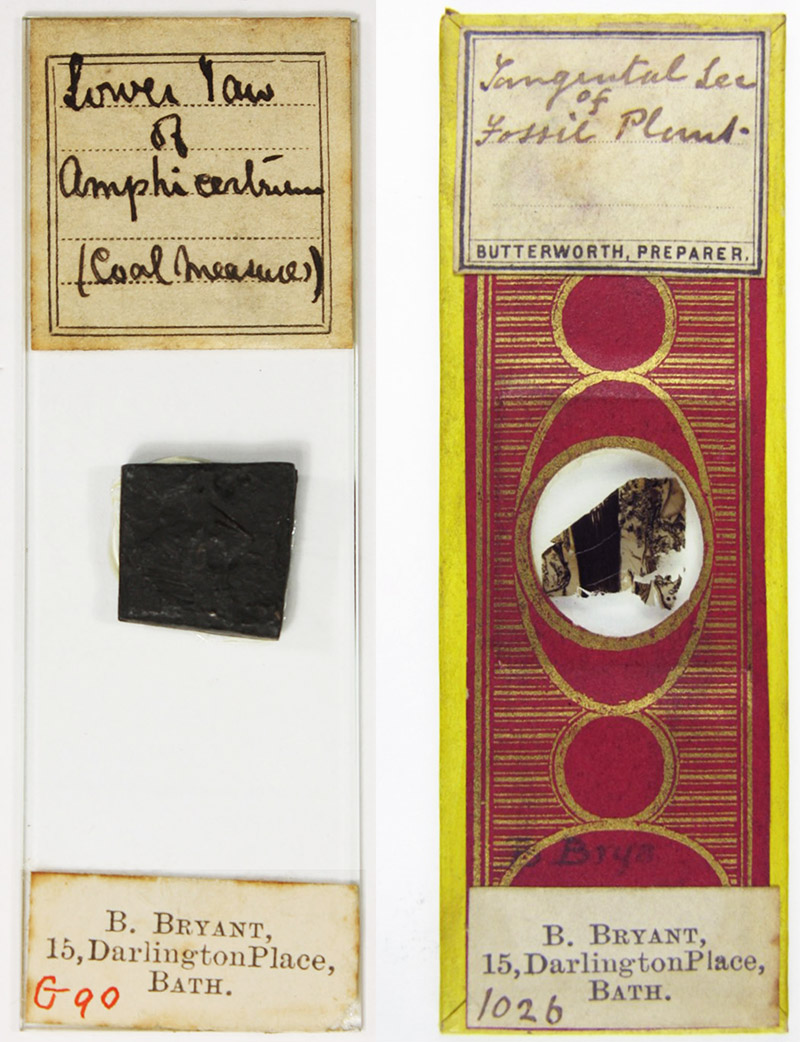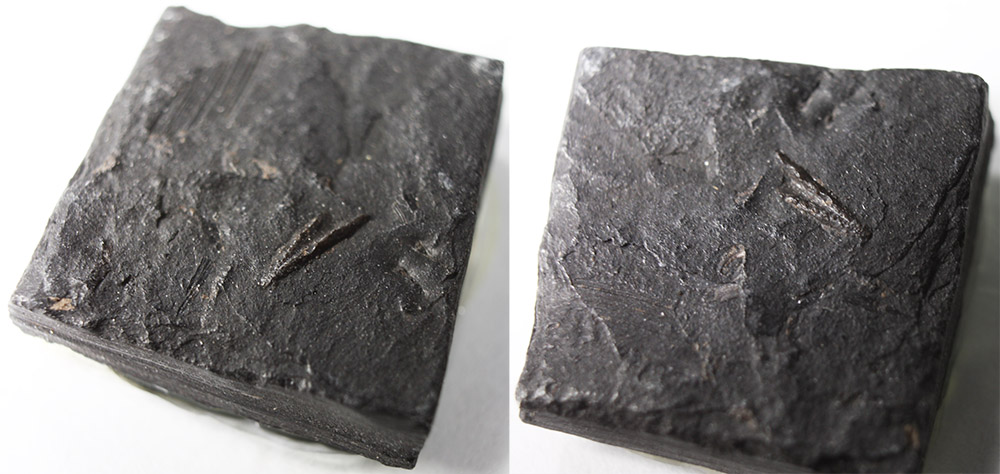Elizabeth (Bessie) Bryant, 1855 - 1924
by Brian Stevenson
last updated July, 2020
A rarity in Victorian times, Bessie Bryant was an active naturalist and microscopist. She taught science at a girls’ school in Bath, England. Bryant joined the Postal Microscopical Society in 1882. In 1904, she was the corresponding member of the Bath Ladies Microscopical Society. By 1914, she had moved to Clifton, Bristol, and joined the Bristol Naturalists’ Society.
Bryant’s microscope slides are relatively uncommon - she is mentioned in Bracegirdle’s “Microscopical Mounts and Mounters”, but that author did not have an example available for illustration. Figures 1 and 2 show a finely-prepared fossil from coal, and displays considerable skill.
Two addresses are known to be shown on Bryant’s slides, both of which are in Bath. From at latest 1881, she lived at 2 Duke Street. During the mid-1890s, she moved to 15 Darlington Place. By 1911, she had moved to 11 Darlington Street, Bath. It is probable that Bryant continued to prepare microscope slides at Darlington Street, and after her ca. 1914 move to Clifton.

Figure 1.
Two microscope slides from Bessie Bryant’s collection. Her address of 15 Darlington Place dates them to between ca. 1895 and ca. 1910. The slide on the left is a thick section of dense coal, approximately 2 mm thick, glued onto a standard 1x3 inch glass slide. The slide on the right was acquired by her from John Butterworth.

Figure 2.
“Lower jaw of amphibian (from a) coal measure”, details of the specimen on the Bryant slide shown in Figure 1. Photographed with a digital SLR camera with macro lens.
Bessie Bryant was born in Bristol during 1855. She was the second daughter, and third child, of Charles and Elizabeth Bryant. Her father owned a leather-making business; the 1871 census listed him as “master currier, employing 7 men, 2 porters, & 4 boys”. The Bryant family enjoyed the benefits of a domestic servant.
The 1861 census shows that 7 year-old Bessie and her elder brother, 8 year-old Charlie, lived away at a boarding school in Keynsham, Somerset. The eldest child, 11 year-old Kate, lived with their parents and younger siblings. Kate was listed as being a “scholar”, indicating that she attended a local school. The reason for sending the second and third children away is not clear - perhaps the Bryants wanted their eldest son to receive the benefits of that boarding school, and Bessie was sent along to keep him company. Whatever the logic, it seems to have set Bessie’s course for a life in education.
The 1871 census shows Bessie as a 16 year-old “scholar”, boarding at a school in Walcot, Somerset. The school was administered by the mother and daughter pair of Anne and Emma Long. The school boarded seven other girls, aged 5 to 16. Two domestic servants took care of household duties.
By 1881, Emma Long had become the head mistress of the Duke Street Girl’s School, in Bath, a long- established institution (Figure 3). Bessie joined Long as a teacher, and boarded at the school. The school’s address, 2 Duke Street, Bath, is found on the oldest of Bryant’s known microscope slides.
Bryant joined the Postal Microscopical Society in June, 1882, giving the school as her home address. She was noted in the 1884 Journal of Microscopy and Natural Science as having provided drawings of microscopical views of a viper’s fang and commented to Postal Microscopical Society members on a preparation of an echinus spine.
Bessie’s youngest sister, Alice, joined her as a teacher at the Duke Street School. The 1891 census listed Bessie as “teacher of dancing & science”, while Alice was “teacher of music”.
The Duke Street School’s headmistress, Emma Long, left the school during the mid-/late-1890s. Bessie Bryant moved with her, although it is possible that she continued her position as a teacher at Duke Street without boarding there. In 1900, Bryant published an exchange request from her new home at 15 Darlington Place, Bath (Figure 4).
The 1901 census lists Bessie Bryant, Emma Long, two other ladies, and a servant, at 15 Darlington Place. Long did not have a listed occupation, so was probably retired at that time. Bryant was listed as her “boarder”, while the other two ladies were “visitors”. Bessie Bryant’s occupation was “science teacher”.
Around that time, Bryant joined the Bath Ladies Microscopical Society. She was their corresponding secretary. A 1904 issue of The Journal of the Quekett Microscopical Club listed “societies, etc., that receive the Journal”, among which was “Bath Ladies Microscopical Society, Miss B. Bryant, 15, Darlington Place, Bath”.
Also in 1904, Bryant responded to a query that had previously been posted in Knowledge, “In answer to your query as to Mr. Warburton's article on ‘Mites’, Mr. Warburton says he uses concentrated carbolic acid for clearing. I am aware that this sometimes leads to difficulties in subsequent mounting in Canada balsam, but Mr. Warburton says he has no difficulty with it. With regard to the parasitic growths upon Parnus prolifericornis, if you will send me the beetle I will see what I can do with it. Miss B. B. Bryant, Bath”.
The 1911 census listed Bessie Bryant as a boarder in a home at 11 Darlington Street, Bath. She was listed as having “private means” - being only 55 years old, she was probably still a school teacher.
Soon afterward, she moved to Bristol. The 1914 and 1923 membership lists of the Bristol Naturalists’ Society give her address as 7 West Park, Clifton. At a 1914 meeting, Bryant exhibited “fossil shells from red crag of Suffolk”.
Bessie Bryant died at home on March 27, 1924. Her sisters, Kate and Alice, were the executrixes of her will.

Figure 3.
Circa 1890 description of the Duke Street Girls’ School, where Bessie Smith was the teacher of science and dance.

Figure 4.
A 1900 exchange offer from Bessie Bryant, of 15 Darlington Place.
Acknowledgement
Thank you to Richard Courtiour for generously sharing a picture of his Bessie Bryant microscope slide.
Resources
Bracegirdle, Brian (1998) Microscopical Mounts and Mounters, Quekett Microscopical Club, London, page 18
Bryant, Bessie (1904) Letter, Knowledge, Vol. 27, page 195
England census and other records, accessed through ancestry.com
The Journal of Microscopy and Natural Science (1884) Vol. 3, pages 12 and 252, and Plate 28
The Journal of the Postal Microscopical Society (1882) Members, Vol. 1
The Journal of the Quekett Microscopical Club (1904) Second Series, Vol. 9, page xxv
Post Office Directory of Bath (undated)
Probate of the will of Bessie Bryant (1924) “Bryant Elizabeth of 7 West Park Clifton Bristol spinster died 27 March 1924 Probate Bristol 10 May to Kate Harris widow and Alice Bowman Bryant spinster. effects £1112 13s 6d”, accessed through ancestry.com
Proceedings of the Bristol Naturalists’ Society (1914) Members, page 105
Proceedings of the Bristol Naturalists’ Society (1914) Meeting report, page 119
Proceedings of the Bristol Naturalists’ Society (1923) Members, page 100
Science-Gossip (1900) Exchange offer from Bessie Bryant, New Series, Vol. 6, page 320



